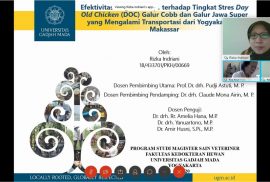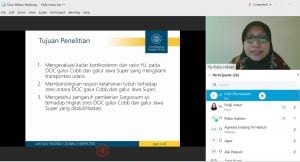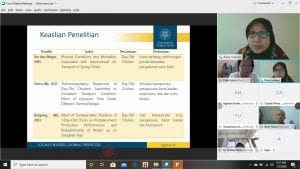Seminar Hasil
Program Studi Magister Sains Veteriner telah menyelenggarakan kegiatan seminar hasil via daring/online pada tanggal 2 Juli 2020 untuk mahasiswa a.n Rizka Indriani dengan judul “Efektivitas Sargassum sp. terhadap Tingkat Stres Day Old Chicken (DOC) Galur Cobb dan Galur Jawa Super yang Mengalami Transportasi dari Yogyakarta ke Makassar”. Mahasiswa ini merupakan bimbingan dari Prof. Dr. drh. Pudji Astuti, M.P. dan Dr. drh. Claude Mona Airin, M.P.
by Agus Sumantri (Dinas Peternakan Kabupaten Sumbawa NTB)
Supervisor : Prof. Drh. Widya Asmara, SU., Ph.D. and Dr. drh. Widagdo Sri Nugroho, MP
Anthrax has been a problem in Sumbawa District. There has been casualties and economic loss to livestock mortility since the last 7 years (2002 – 2009). This study was to identify the influential factors of Anthrax cases in Sumbawa.
The sample were 67 Anthrax cases and 67 controls ( each consist of, 31 cattle, 25 buffaloes, 3 horses and 8 goats) were taken as samples. The samples were based on the Anthrax incidents in Sumbawa District during the 2002 -2009 period.
The description of breeders and livestocks in Sumbawa District involved the lower level of livestock owners’ education (38.8%); the average livestock ownership of 13 ±2.53 (95.52%); non-vaccinated livestocks due to unhealthy reason (56.3%); managerial factor, i.e. daily placement of livestock at rice fields (59.7%); sick livestock treatment of being death as corpse (49.7%); unsupervised butchering process by Dinas Peternakan (Office of Livestock) (71.9%); using market as meat distribution point (40.6%), unreported sick livestocks to Dinas Peternakan (89.6%), using reason of ignorance for not reporting (40%); environment factor, i.e. rice field as mortality location of livestock (32.8%), flat land as the mortality place of livestock (77.6%), river proximity as the mortality place of live stock (77.6%), wet season as the Anthrax incident time (83.6%), the middle of wet season as the time of incident (76.8%), rice field as village surrounding (61.2%), corpsestreated as dogs’ prey (31.4%), not using housing area as burial/burning point (54,2%), the soil pH average of 6.9 ± 0.1, temperature between 19.7°C – 35.5°C, humidity between 21.8 – 99.0%, average rainfall of 4.28 ± 0.37, average wind speed 5.71 ± 0.05 knots, average wind direction 194.63 ± 11.123, and average Anthrax incident place elevation of 59.87 ± 11,05 m dpi. Factors associated to Anthrax incident in Sumbawa District involved unvaccinated livestock (OR=157.33), the availability of kokar/seasonal creek (OR= 25.1), livestock drinking point mixed with neighbors’ livestocks (OR=20.83), flat land as daily place of livestocks (OR= 19.04), wild dog availability (OR= 12.07), range scavenging livestock rearing system (OR=6.78), food freely searching system for livestock (OR=6.78), livestock feeding point mixed with neighbors’ livestock (OR= 5.82), grazing with neighbor livestock (OR=5,82), and land situated at lower land (OR= 4.02).
In general the Anthrax spreading in Sumbawa district seems to follow the water flow pattern, which is from higher to lower area, from up stream to down stream. In addition, the livestock traffie was also suspected to pray a role in Anthrax spreading. The role of dogs in Anthrax distribution needs further study.
Keywords : Anthrax, Bacillus anthracis, risk factors
Poultry traditional market is one of the source AI viruses (AIV) which is important in the incidence of AI, therefore controlling AI in the poultry market is a priority. The purpose of this study was to analyze the risk factors in the poultry market in Yogyakarta Special Province which is associated with the occurrence of AI. Knowing the risk factors are expected to increase the effectiveness of control AI virus which focused on the source of this disease. Cross-sectional study approach were used in this study by taking oropharing swab samples from 487 birds of 90 traders. Isolation was conducted at Disease Investigation Centre (DIC) Wates Yogyakarta. The results of the questionnaire data were analyzed descriptively. Chi-square (χ2) test was used to study the association between the factors studied and the occurrence of AI whereas odd ratio (OR) test was used to measure the strength of the association with 95% confidence level. From positive results variables that provide highly significant difference (P <0.01) on the occurrence of AI in poultry market were variable origin of the poultry sold in the market with χ2 = 6,95, (OR = 0,07), poultry slaughter special place with χ2 = 6,94. (OR = 4,96), and variable of birds that are not sold with χ2 = 10,85 and OR = 3,32 for the birds that remain in the market and OR = 0,22 for birds that are brought home. Variables that provide significant were variable type of transportation used by the traders with χ2 = 8,44, and OR = 6,33 for bike, OR = 0,16 for motorcycles, and OR = 5,25 for cars; variable market location with χ2 = 4,48, (OR = 3,53); variable location of the poultry sold in the market place with χ2 = 4,05, (OR = 3,79), and variable habit to wash hands after handling poultry with χ2 = 5,4, and (OR = 4.16). Non-significant variable were related to activities of spraying disinfectant on the poultry market, the variables mixing of birds from different species in one basket and the variable related to knowledge about AI by poultry traders.
Key words: avian influenza, risk factors, tradisional poultry markets, isolation of virus, traders.
Supervisor: Prof. drh. Charles Rangga Tabbu,MSc, Ph.D and drh Heru Sustya MP., Ph.D.








